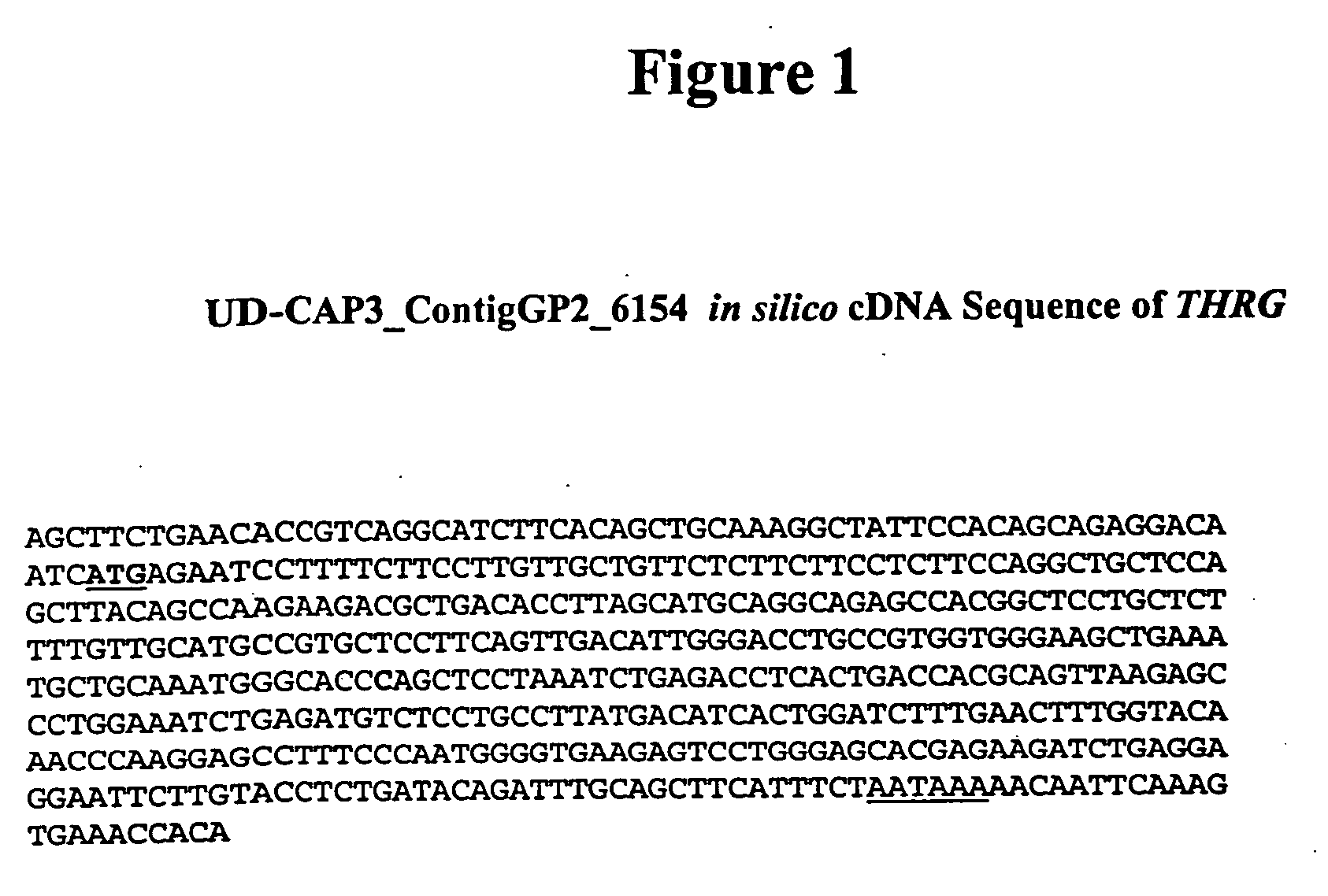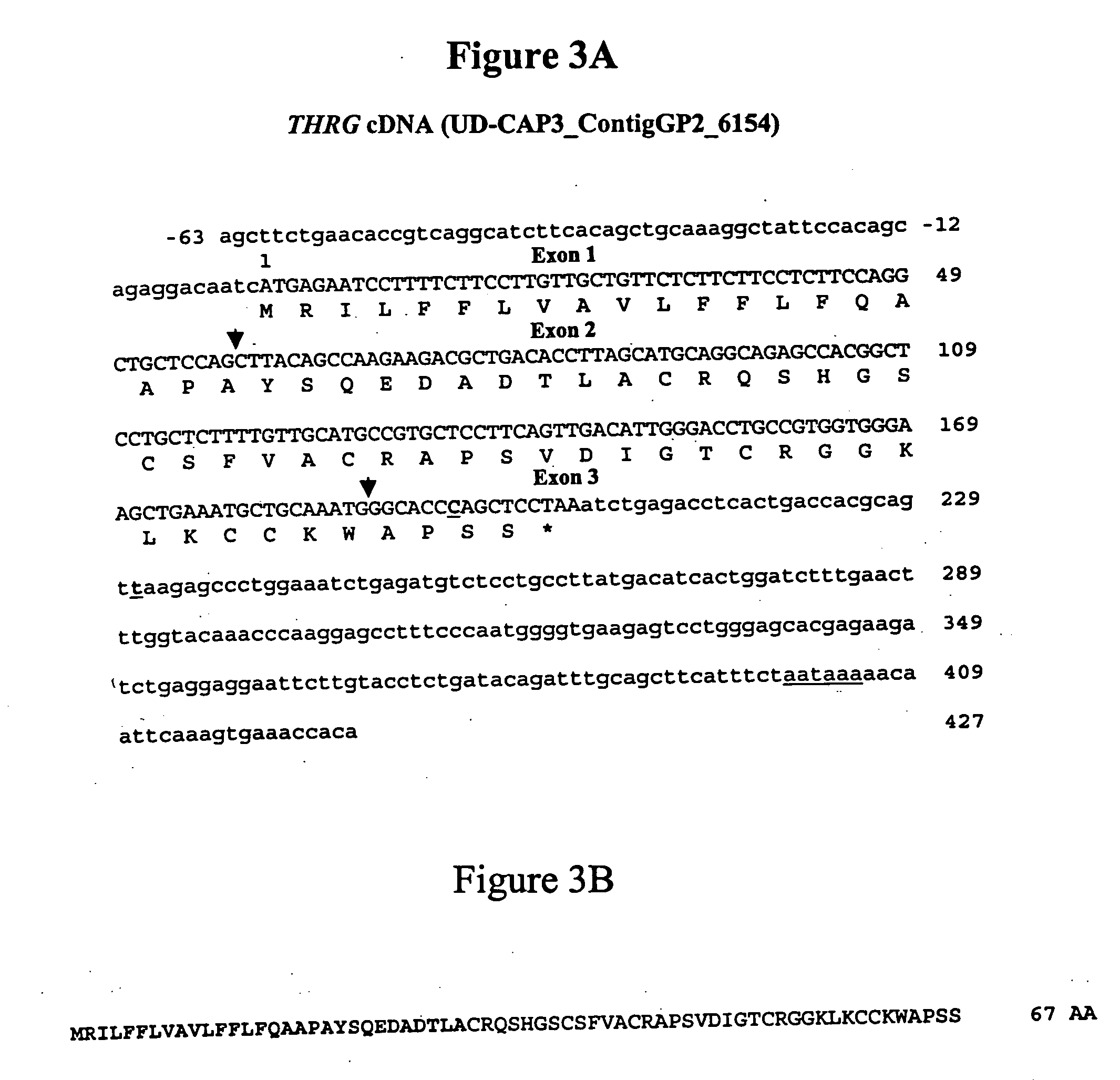Molecular markers for identification of fat and lean phenotypes in chickens
a technology of phenotypes and molecules, applied in the field of methods for identifying the phenotype of chickens, can solve the problems of reducing feed efficiency and lean meat yield, increasing fatness, and excessive adiposity
- Summary
- Abstract
- Description
- Claims
- Application Information
AI Technical Summary
Benefits of technology
Problems solved by technology
Method used
Image
Examples
example 1
Identification of SNPs in THRG
[0078] Materials and Methods
[0079] Cell Culture
[0080] Chicken hepatoma LMH cells (Kawaguchi et al., 1987. Establishment and characterization of a chicken hepatocellular carcinoma cell line, LMH. Cancer Res. 47, 4460-4464) were cultured in Williams' E medium as previously described (Lefevre et al., 2001, “Effects of polyunsaturated fatty acids and clofibrate on chicken stearoyl-CoA desaturase 1 gene expression”, Biochem. Biophys. Res. Commun. 280, 25-31). One day before the experiments, cells were cultured without serum. Cells were then incubated for 6 h with 10% (v / v) fetal calf serum (FCS), 1 mM insulin, 1.5 mM triiodothyronine (T3), 50 mM eicosatetraïonic acid (ETYA) or 1 mM dexamethasone (Dexa) before RNA extraction. Control cells were incubated without serum and effectors. HepG2 cells (Knowles et al., 1980 Human hepatocellular carcinoma cell lines secrete the major plasma proteins and hepatitis B surface antigen. Science 209, 497-499) were cultur...
example 2
Quantitative RT-PCR for Detection of RNA Expression Levels
[0104] For each sample to be tested, the reaction mixture is prepared by combining appropriate amounts of reagents shown in [1]. The reaction mixture is placed into wells of a 384-well plate and the plate is processed by the ABI Prism® 7900HT Sequence Detection System (Applied Biosystems, Foster City, Calif., USA). The parameters of thermocycler are set as indicated by the instruction manual supplied by the manufacturer. Data are collected and analyzed using the Sequence Detection System (SDS) software (Applied Biosystems) to get a Ct value, where Ct is the number of PCR cycles required to reach the detection threshold. The Ct value is converted into the absolute amount of RNA template in the test sample, where smaller Ct values represent higher mRNA levels.
[1] Q RT-PCR reaction mixture (Quantitect ®Sybr-Green RT-PCRKit (Cat. # 204243); QIAGEN Inc., Valencia California, USA)Forward primer:0.5μMReverse primer0.5μMRT-PCR mas...
example 3
Allele Detection for RNA Using TaqMan® Minor Groove Binding Assay
[0114] For each DNA sample to be tested, two reaction mixtures are prepared by combining appropriate amount of reagents shown in [2] and [3]. The reaction mixtures are placed into separate wells of a 384-well plate and the plate is processed by the ABI Prism® 7900HT sequence detection system (Applied Biosystems) The thermocycler parameters are set as indicated by the manufacturer's instructions. When the thermocycler is done, data collected are analyzed using the Sequence Detection System (SDS) software (Applied Biosystems) to determine if the reaction is positive or negative for a particular base substitution. The genotype is then assigned to the tested sample based on either a positive or negative reaction. Detection of fluorescence from 6FAM indicates the presence of T at the SNP; fluorescence from VIC indicates the presence of C at the SNP. The genotype is then assigned to the tested sample based on either a posit...
PUM
| Property | Measurement | Unit |
|---|---|---|
| Volume | aaaaa | aaaaa |
| Volume | aaaaa | aaaaa |
| Molar density | aaaaa | aaaaa |
Abstract
Description
Claims
Application Information
 Login to View More
Login to View More - R&D
- Intellectual Property
- Life Sciences
- Materials
- Tech Scout
- Unparalleled Data Quality
- Higher Quality Content
- 60% Fewer Hallucinations
Browse by: Latest US Patents, China's latest patents, Technical Efficacy Thesaurus, Application Domain, Technology Topic, Popular Technical Reports.
© 2025 PatSnap. All rights reserved.Legal|Privacy policy|Modern Slavery Act Transparency Statement|Sitemap|About US| Contact US: help@patsnap.com



